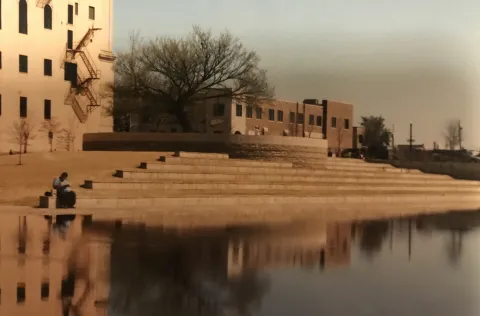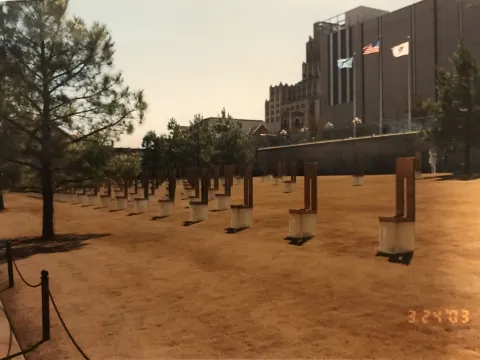Oklahoma City 25 years ago

Part of the Memorial with the Survivor Tree and the pool.
It has been almost 25 years since the bombing of the Alfred P. Murrah Federal Building in Oklahoma City. While this is not a Tennessee event, it is something that should not be forgotten. At 9:02 a.m., on April 19th, 1995, a U-Haul truck, parked in front of the building, exploded, tearing apart the entire front of the multi-storied structure. The explosion killed 168 people, including 19 children. Almost 700 people were injured. Many other buildings were either damaged or destroyed. The face of downtown Oklahoma City was changed forever . . . and so were her people.
The attack was the brainchild of Timothy McVeigh, a young ultra-militant member of the Patriot Movement. He said he did it in retaliation to the raid of the Branch Davidian compound in Waco, Texas. His compatriot was Terry Nichols, a buddy from his Army days. McVeigh was caught the same day, even while the injured were being found in the wreckage. Nichols turned himself in a couple of days later. Both were convicted of murder.
I have roots in Oklahoma. My father moved to Oklahoma City with his family just before the Great Depression. He and my aunt graduated from Classen High School and my dad enlisted in the military at the outbreak of World War II. My aunt married an Oklahoma farmer and lived just outside of the city. I lived in a suburb of Oklahoma City while my dad was in Vietnam in 1965. When I heard the news, I knew my relatives wouldn’t have reason to be in downtown Oklahoma City, but I worried nonetheless and was relieved when I heard they were safe.
Later, my older brother, Bob, and I visited my Uncle Ted. We decided to go downtown and see the memorial. Not long after the building had been razed, a beautiful memorial was built on the spot. We didn’t go into the museum, but wandered the grounds. We were moved by the glass and stone chairs sitting empty in rows with only the names of the dead etched on them. An oak “survivor tree” still stands as a testament to the resiliency of the survivors and the people of the area. A shallow pool of water brings peace. A clock shows the exact time the explosives went off. A nearby fence is most poignant, holding stuffed animals, ribbons, notes and other paraphernalia left to comfort the survivors and honor the dead.
The greatest act of domestic terrorism in history . . . May we never forget.
Susan Kite is the author of five young adult novels. She also has a novelette included in Zorro, the Daring Escapades due for publication on May 1 and a children’s book, The Legend of Billy Bob Flybottom, set to be published in the fall by Doodle and Peck. Check out her books at http://amazon.com/author/bookscape
- Log in to post comments

Bombing
Good reminder, Susan.